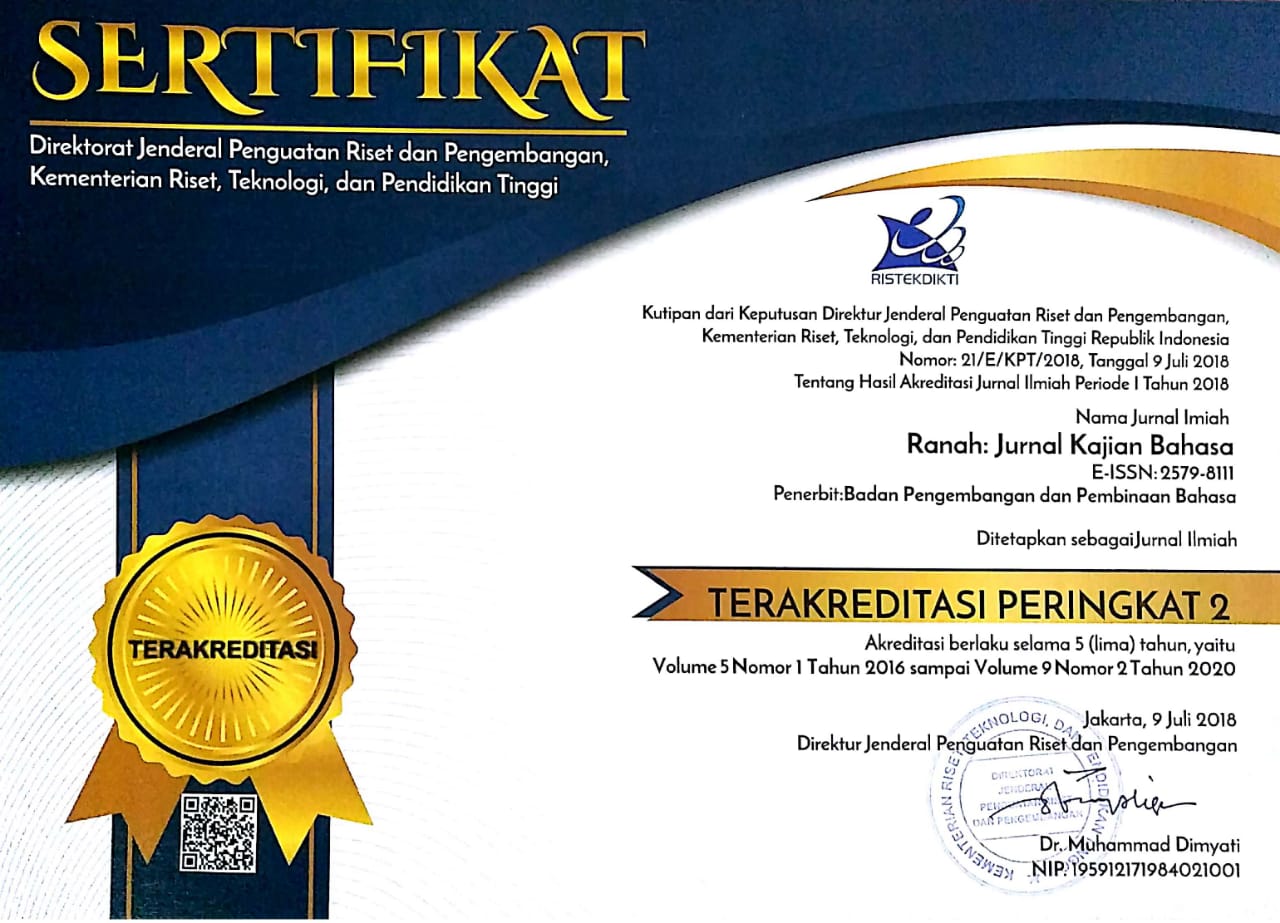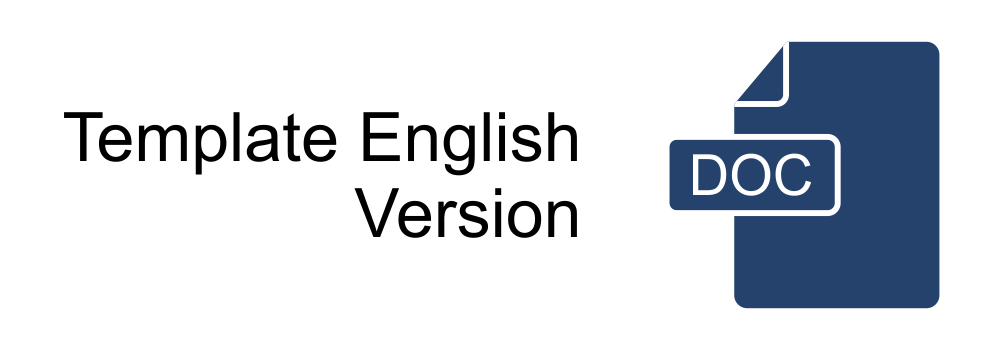Metafungsi Interpersonal Siberteks Vaksinasi Covid-19: Perspektif Multimodalitas
Abstract
The purpose of this study was to describe the interpersonal metafunctions of the Covid-19 vaccination cybertext in a multimodality perspective. The source of the locational data for this research was the posters of Covid-19 vaccination obtained from google pictures which have been downloaded and acknowledged that their citation was in accordance with applicable scientific procedures, so that they did not conflict with ethical clearance principles of internet-based research. The data of this research were in the form of speeches and graphic images contained in Covid-19 vaccination posters which contain interpersonal metafunctions. Data were collected by reading and taking notes. The method that accommodates the two data collection techniques was the observation method. Data that had been collected properly is selected to separate good data from bad data. Good data were then classified to obtain data types to be subjected to data analysis methods and techniques. Data were validated against relevant experts and theories. The data were analyzed using the extra lingual equivalent analysis method. The matching process was carried out on the extra lingual aspects. The results of this research on interpersonal metafunctions in this multimodality perspective were: (1) Interpersonal metafunctions that provide clarity on the flow of the Covid-19 vaccination, (2) Interpersonal metafunctions that motivate people to undergo Covid-19 vaccination, (3) Interpersonal metafunctions for inviting the success of the Covid-19 vaccination program, (4) Interpersonal metafunctions that provide an explanation for the impact of Covid-19 vaccination, (5) Interpersonal metafunctions invite residents to administer Covid-19 vaccinations. With the findings of metafunction in cybertext through the research, it can be emphasized that interpersonal metafunctions in a multimodality perspective can manifest in various ways. The diversity of these manifestations cannot be separated from technology as a major part of culture which determines the development of language in this new era.
Abstrak
Tujuan penelitian ini adalah mendiskripsikan manisfetasi metafungsi interpersonal teks siber vaksinasi Covid-19 dalam perspektif multimodalitas. Sumber data lokasional penelitian ini adalah poster-poster vaksinasi Covid-19 yang diperoleh dari google pictures yang telah diunduh dan diakui penyitirannya sesuai dengan prosedur ilmiah yang berlaku, sehingga tidak bertentangan dengan prinsip-prinsip etik (ethical clearance) penelitian berbasis internet. Data penelitian ini berupa tuturan dan gambar grafis yang terdapat dalam poster-poster vaksinasi Covid-19 yang di dalamnya terkandung metafungsi interpersonal. Data diperoleh di seputar waktu pelaksanaan penelitian, yakni pertengahan hingga akhir tahun 2021. Data dikumpulkan dengan teknik membaca dan mencatat. Metode yang mewadahi kedua teknik pengumpulan data tersebut adalah metode simak. Data yang telah dikumpulkan dengan baik diseleksi untuk memisahkan data baik dan data nakal atau tidak baik. Data yang baik selanjutnya diklasifikasi untuk mendapatkan tipe-tipe data untuk dikenakan metode dan teknik analisis data. Data divalidasikan kepada pakar dan teori yang relevan. Data dianalisis dengan metode analisis padan ekstralingual. Lanskap pemadanan dilakukan pada aspek-aspek ekstralingualnya. Hasil penelitian metafungsi interpersonal dalam perspektif multimodalitas ini ini adalah: (1) Metafungsi interpersonal pemberi kejelasan alur pelaksanaan vaksinasi Covid-19, (2) Metafungsi interpersonal pemotivasi orang menjalani vaksinasi Covid-19, (3) Metafungsi interpersonal pengajak menyukseskan program vaksinasi Covid-19, (4) Metafungsi interpersonal pemberi penjelasan dampak vaksinasi Covid-19, (5) Metafungsi interpersonal pengajak warga melaksanakan vaksinasi Covid-19. Dengan temuan-temuan metafungsi dalam siberteks tersebut dapat ditegaskan bahwa metafungsi interpersonal dalam perspektif multimodalitas dapat bermanifestasi beragam. Keberagaman manifestasi tersebut tidak lepas dari teknologi sebagai bagian pokok dari budaya yang menjadi penentu perkembangan bahasa di era baru sekarang ini.
Keywords
Full Text:
PDF (Bahasa Indonesia)References
Armstrong, E., & Ferguson, A. (2010). Language, meaning, context, and functional communication. Aphasiology. https://doi.org/10.1080/02687030902775157
Aveling, H. (2005). Two Approaches to the Positioning of Translations A Comparative Study of Itamar Even-Zohar's "Polysystem Studies" and Gideon Toury's "Descriptive Translation Studies and Beyond." Kritika Kultura. https://doi.org/10.13185/1541
Bloor, T. (2004). The functional analysis of English: A Hallidayan approach. Discourse Studies. https://doi.org/10.1177/1461445606069334
Dant, T. (2008). The "pragmatics" of material interaction. Journal of Consumer Culture. https://doi.org/10.1177/1469540507085724
Duranti, A. (1997). Linguistic Anthropology. In International Encyclopedia of Social & Behavioral Sciences. https://doi.org/10.1007/s13398-014-0173-7.2
Enfield, N. J. (2009). Relationship thinking and human pragmatics. Journal of Pragmatics. https://doi.org/10.1016/j.pragma.2008.09.007
Finegan, E., & Chaika, E. (1985). Language: The Social Mirror. Language. https://doi.org/10.2307/414431
Gerbig, A. (2003). The Ecolinguistics Reader: Language, Ecology and Environment. Current Issues in Language Planning. https://doi.org/10.1080/14664200308668051
Haider, I. (2019). Cyberpragmatics. In Global Perspectives on Language Assessment. https://doi.org/10.4324/9780429437922-11
Halliday, M. A. K. (1975). Learning how to mean : explorations in the development of language. In Explorations in language study. https://doi.org/10.1016/B978-0-12-443701-2.50025-1
Halliday, M. A. K. (2015). Language as social semiotic. In Soziosemiotik. Grundlagentexte. https://doi.org/10.1016/0346-251X(81)90015-4
Hoye, L. F. (2006). Linguistic anthropology and pragmatics. In Journal of Pragmatics. https://doi.org/10.1016/j.pragma.2005.04.001
Jeannerod, M. (1995). Mental imagery in the motor context. Neuropsychologia. https://doi.org/10.1016/0028-3932(95)00073-C
Kramsch, C. (2002). Language and Culture: A Social Semiotic Perspective. Adfl. https://doi.org/10.1632/adfl.33.2.8
Kress, G. (1990). Critical Discourse Analysis. Annual Review of Applied Linguistics. https://doi.org/10.1017/S0267190500001975
Leeuwen, van T. (2005). Introducing Social Semiotics (1st ed.). Routledge. https://doi.org/10.4324/9780203647028
Locher, M. A. (2013). Cyberpragmatics: Internet-Mediated Communication in Context. Journal of Pragmatics. https://doi.org/10.1016/j.pragma.2012.12.002
Mahsun, M. (2005). Metode Penelitian Bahasa. Jakarta: PT Raja Grafindo Persada. https://doi.org/10.1200/JCO.2008.17.1991
Malinowski, B. (1925). Magic, science and religion. In Science, religion and reality. https://doi.org/10.2307/2104095
Mondada, L. (2018). Greetings as a device to find out and establish the language of service encounters in multilingual settings. Journal of Pragmatics. https://doi.org/10.1016/j.pragma.2017.09.003
Murray, J., Morgenstern, D., Furstenberg, G., & Athena, T. (2009). Critical Concepts in Linguistics. Foundations. https://doi.org/10.1021/ja01493a016
Rahardi, K. (2019). Contexts as The Determining Roles of Javanese Phatic 'Monggo': Culture-Specific Pragmatics Perspective. Indonesian Language Education and Literature. https://doi.org/10.24235/ileal.v5i1.5035
Rahardi, K. (2020). Pragmatik: Konteks Ekstralinguistik dalam Perspektif Cyberpragmatics. Penerbit Amara Books. https://doi.org/10.26499/li.v38i2.132
Rahardi, R. K. (2010). Sosiopragmatik (1st ed.). Erlangga.
Rahardi, R. K. (2016). Personal and Communal Assumptions to Determine Pragmatic Meanings of Phatic Functions. Lingua Cultura, 10(10(2)), 95-98. https://doi.org/10.21512/lc.v10i2.897
Rahardi, R. K. (2018). Konstelasi Kefatisan dalam Teks-teks Natural Religius dengan Latar Belakang Kultur Spesifik. Prosiding Kongres Internasional Masyarakat Linguistik Indonesia 2018.
Rahardi, R. K. (2019). Pragmatic Perspective on Phatic Functions and Language Dignity. International Journal of Engineering and Advanced Technology, 8(5C, May 2019), 261-268. https://doi.org/10.35940/ijeat.E1039.0585C19
Rahardi, R. K. (2020). PRAGMATIK Konteks Ekstralinguistik dalam Perspektif CyberpragmaticsNo Title. Amara Books Yogyakarta. https://doi.org/10.26499/li.v38i2.132
Rahardi, R. K. (2017). Language Phatic in Specific Culture Perspective. 1st International Conference on Education, Language, and Arts, 1165-1174.
Sari, Y. (2018). Multimodalitas dalam Gambar Iklan Luwak White Koffie Versi Lee Min-Ho". Metalingua: Jurnal Penelitian Bahasa, 15(2), 235. https://doi.org/10.26499/metalingua.v15i2.73
Science, L., Company, P., Long, M. H., Canagarajah, S., Peterson, R. A., Nagel, J., Lu, S., Fine, G. A., Pavlenko, A., Eva Lam, W. S., Warriner, D. S., Poveda, D., Gonzalez, N., de Souza, L. M. T. M., McNamara, T., Iwasaki, S., Van Lier, leo, Lemke, L., Modern, T., Backus, A. (2017). An Introduction to Discourse Analysis: Theory and Method. Journal of Pragmatics. https://doi.org/10.1016/0346-251X(88)90022-X
Searle, J. R. (1962). Meaning and Speech Acts. The Philosophical Quarterly. https://doi.org/10.1021/bi700974t
DOI: https://doi.org/10.26499/rnh.v11i1.4196
Refbacks
- There are currently no refbacks.








